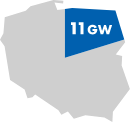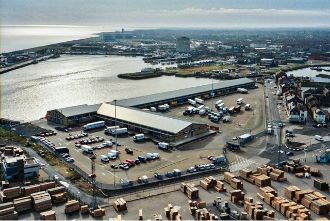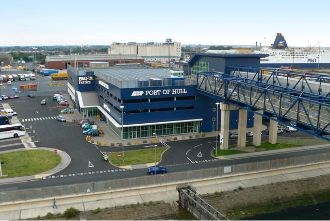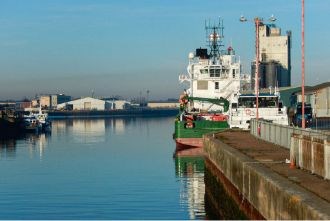Choczewo municipality
Thanks to its location, the Choczewo municipality may soon become one of the most important points on the renewable energy map of Poland. This is where electricity generated by the Baltic Power offshore wind farm and the farms owned by other operators will be transmitted to via submarine cables.
The infrastructure to be built in Choczewo will receive electricity from the offshore wind farm and transmit it into the national power grid. In the onshore section, 220 kV underground cables will be laid as an extension of the submarine cables. They will carry the electricity to Żarnowiec Bis, a new substation under construction whose precise location is yet to be determined, and further by transmission lines to locations across Poland.
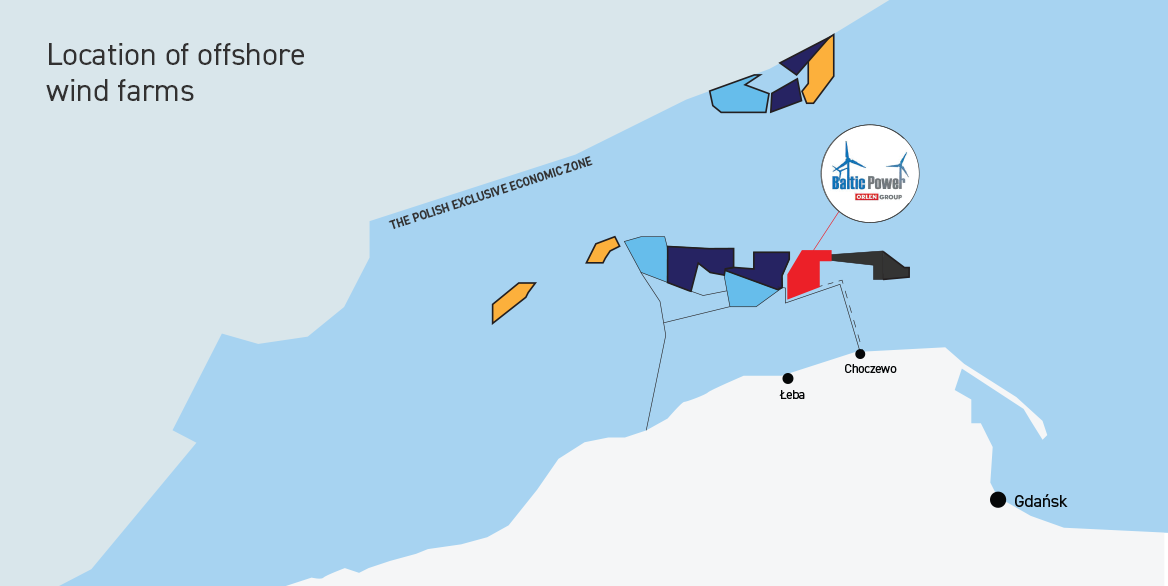
The length of the offshore section will be about 23 km, while the onshore section will be about 8 km long. The onshore part of the connection line will run entirely through the Choczewo Forestry District areas, bypassing the Natura 2000 sites (such as Habitat Natura 2000 PLH220003 – Białogóra) and the Lubiatowska Dune. The cables will be connected to a new substation, to be built by Polskie Sieci Elektroenergetyczne.
The route in its final shape is the result of cooperation between designers and planners as well as a wide group of stakeholders, including district forestry authorities and local governments. When planning a cable route we consider various social and environmental factors. The cable line will be located away from buildings and at the same time it will not affect areas of value for tourists as it will run underground. When choosing the location, the existing zoning plans, landforms, infrastructure and many other factors have also been taken into account. Our priority is to lay the line in a way causing minimum inconvenience for property owners and the natural environment.
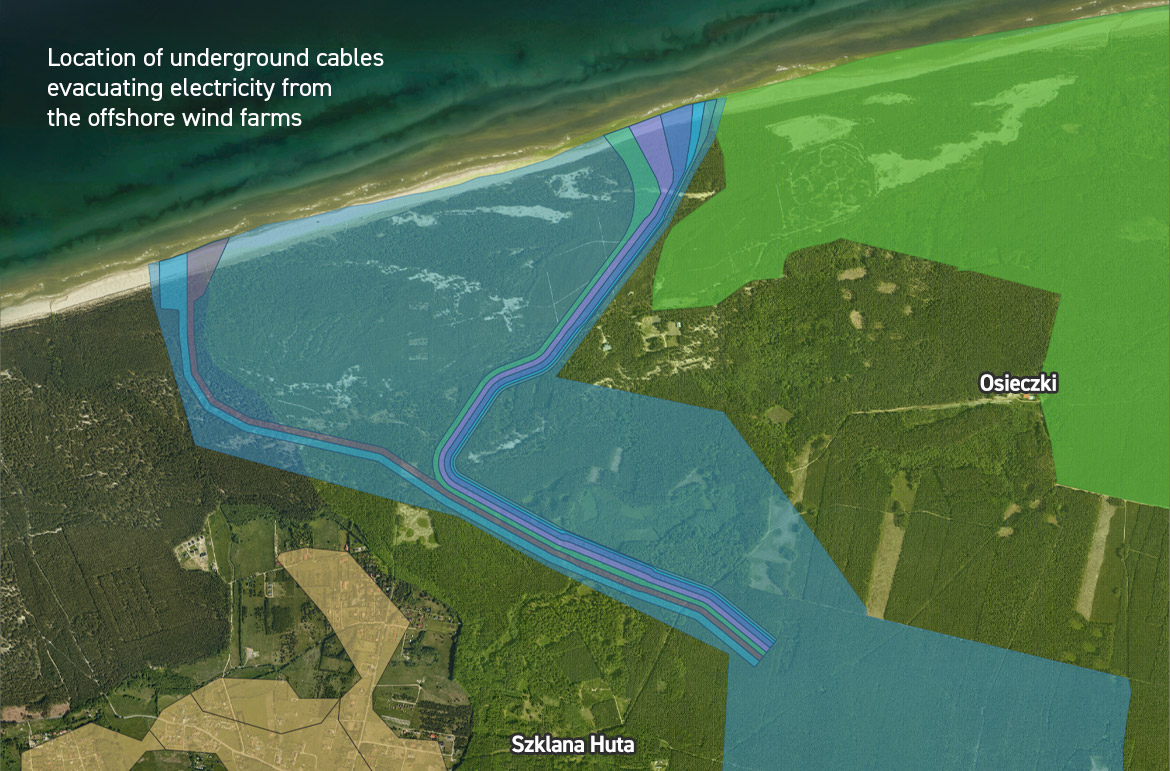
Benefits for the local community
A direct benefit of the project for the residents of the Choczewo municipality and the Pomerania region is the annual tax revenues to the municipality’s budget.
The underground connection cables of the Baltic Power offshore wind farm and the transmission infrastructure facilities owned by other entities will be a source of property tax revenues for long years to come. The taxes will be paid by entities that are the largest state-owned companies in Poland and enjoy a stable position. With this revenue, the municipality will be able to plan long-term investment projects. The development of offshore wind power will also create thousands of new jobs and will be an opportunity to build a completely new and innovative sector of the Polish economy. It is also worth remembering that wind farms will become a new, substantial source of electricity in the country. For people living in the north of Poland and using energy generated in the south, this means greater stability of electricity supply.
Do you know
The capacity of Poland’s largest coal-fired power plant in Bełchatów is over 5 GW of electricity. The total capacity of the Baltic Power offshore wind farms will be similar – approximately 4.7 GW.
According to the Poland’s Energy Policy, by 2040 the potential of offshore wind farms will reach an impressive 11 GW, accounting for approximately one-fifth of the capacity installed in the Polish Power System today.
A study carried out for the Polish Wind Energy Association shows that more than 80% of Poles believe that using energy from offshore wind farms supports the fight against climate change.
Technologies
The submarine cable from the offshore wind farm will be connected to a well situated onshore, where a transition connector to the underground onshore cables will be placed. The 220 kV cable will run entirely under the seabed and then underground.
The onshore well will be located behind the first dune, about 150 meters from the coastline. This will be the first infrastructure element visible to the local residents, having the form of a concrete slab on the ground. Four onshore cable connections are to be ultimately built in the Choczewo municipality. The approximate diameter of the cable used for lines of this type is about 120 mm.
A part of the project of about 800 metres from the coastline inland will be carried out using a trenchless method (horizontal direct drill), which means that the beach will remain intact.
In the further section of the cable line, leading to the planned power substation, it will be necessary to cut down trees to ensure safe operation of the underground line (with the exception of the peat bog, which in another area where controlled directional drilling work is planned).
The cable will be laid in the ground at the minimum depth of 1.1 metre below the ground level.

The farms will be located at least 22 kilometres from the beach. This means that they will be barely visible on the horizon and will not affect the seaside landscape of the tourist resort.
The evacuation cables will run under the seabed and then under the beach, at a depth of about 10 meters. They will be laid using a trenchless technology, such as controlled directional drilling. This means that in the onshore section, on the beach and just beyond it, the area will not be affected.
Wells located behind the beach in the forest will be the first visible elements of the project. In practice, these will be manholes leading to a small underground room in which sections of the cables running from the sea will be connected to underground onshore cables.
Underground cable routes are designed to bypass the Lubiatowska Dune, an important landmark and point of attraction for tourists in the municipality. The section’s part east of the dune, which is several hundred metres long, will also be made using a trenchless technology, such as controlled directional drilling.
Underground cables from all planned offshore wind farms will be laid within a single belt about 150 meters wide. This is designed to prevent the risk of each farm seeking to lay its cables independently of the other connections, unnecessarily affecting various parts of the municipality area.
Underground cables from offshore wind farms will be connected to the newly built PSE substation in the Choczewo 2 municipality. From there, the power will be supplied to customers across Poland by means of overhead high voltage lines. The exact location of the lines will be defined during further design and planning work.
Examples from abroad
Examples of British seaport towns that have benefited from the process of business transformation towards offshore wind farms.
GRIMSBY
Grimsby is a seaport town in the Lincolnshire county, located on the east coast of the UK. Until recently, the structural unemployment rates in Grimsby were among the highest in the country. The town’s economy recovered once investments in offshore wind farms were launched. The rapid growth of the offshore wind farm industry has transformed Grimsby into one of the most important Operations and Maintenance (O&M) port hubs for wind farms located on the east coast. There are seven offshore wind farms near Grimsby today. Their development led to the creation of 2,000 new jobs during the construction phase, 200 jobs during the operation phase, and hundreds more jobs for, among others, subcontractors of the companies engaged in the process of wind farm development and servicing. The investments in Port Grimsby alone have produced about 350 permanent jobs. As many as 83% of them are held by the town’s residents.
PORT W HULL
Historically, Hull has been a fishing port. Until recently it was also one of the poorest towns in the UK. The region experienced economic hardship for over 20 years. With the dynamic development of the offshore wind farm sector and related investments, over a period of five years the Hull region has turned into a dynamic port area. Today, the town is an important manufacturing, assembly and operation centre for offshore wind farms located on the east coast of England. Among the projects of key importance to the region was the opening of a wind turbine blade plant (in September 2016), where over 1,000 people found employment. Importantly, as many as 97% of the people working at the plant live within a perimeter of about 50 kilometres.
LOWESTOFT
Lowestoft is the most easterly town in England. In the past, the local harbour was known mainly as a large fishing centre. After GBP 25m was invested in the new operations base, the harbour is now a major offshore wind power centre. The development of the offshore wind sector helped create 100 new jobs in Lowestoft Harbour alone. As the operation of offshore wind farms requires an efficient supply chain, it is believed that several thousand people in the region have been employed in projects directly or indirectly related to offshore wind power generation.
GREAT YARMOUTH
Great Yarmouth is a town in Norfolk (eastern England) , located between the rivers Bure and Yare. Great Yarmouth Harbour used to be famous for fishing, mainly for herring. Many years of challenges and, in consequence, the weakening of the fishing industry, badly affected the entire region. Now that the investment projects have been completed, Great Yarmouth Harbour serves as an installation port for the ongoing East Anglia One project, an offshore wind farm located in the North Sea, approximately 30 miles off the east coast of East Anglia. Its target capacity is 714 MW.
Contact us
In creating this page we aim to present to you our plans and the principles we follow in preparing the project. We also invite you to participate in the consultations we will be holding in the Choczewo municipality. Your opinions and questions about the project are very important to us, which is why we have set up a dedicated mailbox for receiving your questions.
Enquiries by local communities: wiatr@balticpower.pl
Community Liason Officer:
Krzysztof Bukowski,
krzysztof.bukowski@balticpower.pl
609 053 564



